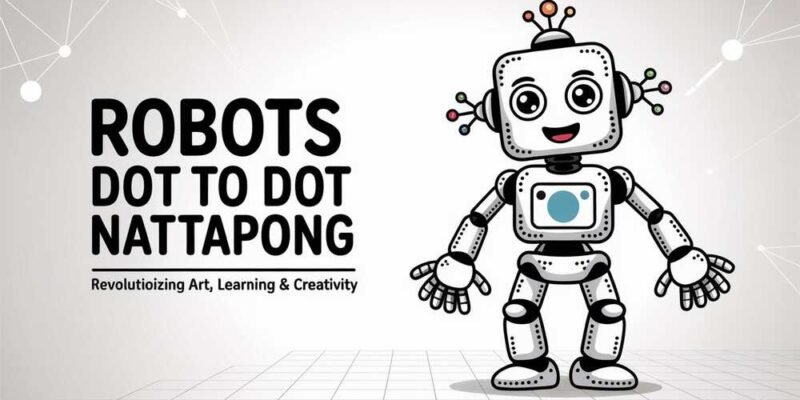Introduction to Robots Dot to Dot Nattapong
In the rapidly evolving landscape of digital creativity and educational technology, one concept is beginning to captivate the attention of both educators and artists alike: “robots dot to dot nattapong.” This innovative approach to interactive learning and digital art is more than just a creative outlet—a groundbreaking fusion of artificial intelligence, robotics, and traditional dot-to-dot activities. This concept allows users to engage in a hands-on experience that stimulates cognitive development and artistic expression. As AI and robotics continue to influence various sectors, the rise of robotic dot-to-dot art marks a notable shift toward integrating intelligent systems with human creativity.
Who is Nattapong?
Nattapong, a visionary creator and educator renowned for merging robotics with interactive education, is at the heart of this movement. With a background in digital innovation and robotics engineering, Nattapong has been instrumental in transforming how we perceive traditional educational methods and artistic creation. His unique ability to blend technology with classic artistic forms has led to the development of robots that can generate dot-to-dot patterns based on user input or pre-programmed algorithms. Nattapong’s work highlights AI’s potential in creative processes and positions him as a pioneer in digital interactive learning. His contributions are helping redefine the boundaries between art, education, and technology.
What is Robots Dot to Dot?
“Robots Dot to Dot” refers to an engaging, technology-enhanced activity where robotic systems or AI algorithms create or assist in generating dot-to-dot illustrations. Unlike the traditional versions, which require manual drawing, this high-tech alternative uses programmed paths and real-time input to produce complex, often interactive, images. The concept maintains the fundamental principles of dot-to-dot art—connecting numbered points to reveal a hidden image—but elevates it through automation, customization, and digital feedback. These robots can be programmed to adapt the complexity of the images based on the user’s age or skill level, making it accessible and enjoyable for a wide demographic.
How the Technology Works
The mechanics behind robots dot to dot nattapong lie in a combination of artificial intelligence, motion control, and digital interface design. A robotic arm or drawing module is typically connected to a computer or mobile app that processes the dot-to-dot design. AI algorithms then analyze input parameters—such as desired complexity, image theme, or user behavior—and generate a sequence of dots the robot follows. These systems can print the designs on paper or display them on a screen for digital interaction. Some models are also equipped with real-time guidance and correction sensors, making them an ideal tool for learning and entertainment. This seamless integration of hardware and software creates a rich, interactive environment where users can witness the transformation of simple dots into intricate artworks.
Educational Value and Cognitive Benefits
One of the most significant advantages of robots dot to dot nattapong is its educational impact. This innovative tool is an excellent resource for enhancing cognitive skills such as hand-eye coordination, spatial reasoning, pattern recognition, and problem-solving. For younger users, it provides an enjoyable gateway to essential STEM (Science, Technology, Engineering, Mathematics) concepts by demonstrating how robotics and programming can be used in everyday creative tasks. Teachers can incorporate these activities into lesson plans to make learning more engaging and interactive. Furthermore, the adaptive nature of the software allows it to meet individual learning needs, ensuring that every student benefits from a personalized educational experience.
Creative Applications Across Age Groups
What makes Robots Dot to Dot Nattapong genuinely remarkable is its versatility. Whether you’re a child discovering shapes and numbers or an adult exploring modern digital art, this platform caters to various interests and skill levels. In educational settings, students use these tools to create art while learning basic coding and robotics principles. In art exhibitions, digital artists employ robotic systems to generate large-scale, algorithmically-designed dot-to-dot artworks. Families can bond at home over shared creative projects that combine fun with hands-on learning. The platform supports individual exploration and collaborative creativity, encouraging users to push their artistic and intellectual boundaries.
Tools, Platforms, and Resources
Several tools and platforms have been developed to support the Robots Dot to Dot Nattapong initiative. Educational kits often come with beginner-friendly robots, pre-designed templates, and mobile apps for customization. Advanced platforms may include programming environments where users can write code to control the robot’s behavior. Some resources also offer cloud-based libraries with downloadable patterns, allowing users to experiment with various artistic styles. These platforms are designed with user-friendliness in mind, ensuring accessibility for individuals with different levels of technical expertise. Whether through a plug-and-play kit or a comprehensive educational suite, these resources make it easy to dive into the world of robotic creativity.
Future Trends and Innovations
Looking ahead, the potential of robots dot to dot nattapong is immense. Future iterations may incorporate virtual and augmented reality to create immersive experiences where users interact with 3D dot-to-dot models. Integration with voice assistants and gesture control is also on the horizon, making the interaction even more intuitive. Developers are exploring enhancing emotional engagement by allowing robots to respond to user reactions, making the creative process more dynamic and responsive. Additionally, with the growing emphasis on personalized learning, we can expect AI-driven platforms that adapt to individual user profiles in real time. This will make learning more efficient and enjoyable, further solidifying the role of robotic art in mainstream education and entertainment.
How to Get Started with Robots Dot to Dot
Embarking on your journey with robots dot to dot nattapong is exciting and straightforward. Start by exploring available kits or platforms online—many of which are designed for beginners and come with comprehensive guides. Choose a system that aligns with your educational, art, or general exploration goals. Most kits include everything needed to begin, such as a drawing robot, templates, and a companion app. Once set up, users can select a design, adjust the difficulty level, and watch as the robot brings the artwork to life. For educators, numerous lesson plans and teaching materials are available to help integrate the tool into the classroom. Online communities and forums also provide support and inspiration, offering a space to share creations and collaborate on new ideas.
Conclusion: The Impact of Nattapong’s Vision
In summary, “Robots dot to dot nattapong” represents a revolutionary intersection of art, education, and technology. By reimagining a simple childhood activity through the lens of AI and robotics, Nattapong has created a dynamic platform that encourages learning, creativity, and innovation. His work extends beyond classrooms and studios, influencing how we think about the role of machines in human development. As we continue exploring the possibilities of intelligent systems, initiatives like this remind us that technology doesn’t just automate tasks—it can inspire, educate, and transform lives. Whether you’re a teacher, parent, artist, or tech enthusiast, there’s something in this creative revolution for everyone to explore and enjoy.
Do Read: Why Secondary Chinese Tuition Is Key to Excelling in Singapore’s Bilingual Education System













